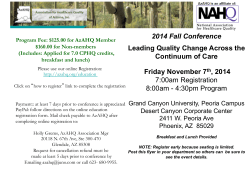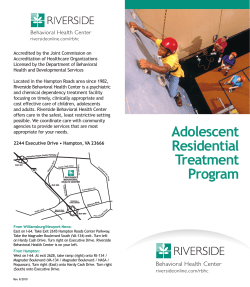
REG 506 RESEARCH DESIGN AND ANALYSIS IN BEHAVIORAL ACCOUNTING RESEARCH
REG 506 RESEARCH DESIGN AND ANALYSIS IN BEHAVIORAL ACCOUNTING RESEARCH Norwegian School of Economics NHH Steve Asare, University of Florida Iris Stuart, NHH If you want to register for the course and you are a PhD student at NHH, please send an email to phd@nhh.no Non- NHH students are required to send in a completed form where they apply for visiting status http://www.nhh.no/no/studentsider/skjema.aspx, together with documentation of admission in the PhD programme at your home institution to phd@nhh.no. If you have any questions concerning participation or other administrative issues, please contact: Turid Røraas, Department of Accounting, Auditing and Law. Purpose: This seminar provides a survey of behavioral accounting research, with a special emphasis on current trends and promising avenues for future studies. The primary difference between behavioral accounting research and other areas (e.g., empirical financial accounting or analytical management accounting) pertains to its behavioral assumptions. Whereas other areas typically assume extreme forms of rationality (e.g., expected utility maximization), behavioral accounting research assumes that human behavior reflects the implications of bounded rationality. Also, instead of assuming that human behavior is motivated by narrow self-interest only, some behavioral studies examine whether broader motives (e.g., fairness and other social factors) are important as well. Another difference is that most behavioral accounting research employs an experimental method. Experimentation has several advantages including control over independent variables and dependent measures of theoretical interest. But, it also has disadvantages including uncertain external validity (i.e., generalizability from laboratory settings to natural field settings). Our survey course includes many experimental studies, but will also cover some field-based behavioral research that addresses concerns about external validity. Teaching and learning methods: The seminar will adopt a discussion format, not a lecture format. All seminar participants are expected to read the assignments in advance and actively join in the discussion. Each session will include 4 primary research articles and often some background reading(s). I have also assigned some general background readings that will not be covered in class but which I expect you to read. Student participants are asked to write and present a research paper/proposal on a behavioral accounting issue. I will work individually with each student to identify the issue and guide the development of the project. The last day of class is reserved for the students’ presentation of their work. Preparation for the course: Prior to the start of the course, each participant should prepare a one-page summary of his or her research agenda (planned or in process). The summary should identify 1) the nature (purpose and subject area) of the research; 2) the research method(s) planned or already adopted; 3) anticipated limitations or difficulties of conducting the research; and 4) progress, if any, to date. Participants should also include a short paragraph indicating what they consider to be the most important learning outcome(s) of attending this course. 2 Learning outcomes: On completion of this unit successful students will be able to: • Understand how different behavioral research methods can and should be used to address different accounting issues. • Critique existing behavioral accounting research papers. • Recognize key issues in gathering, presenting, and analyzing behavioral data. • Assess when experimentation is an appropriate way to address an accounting research question, and why. • Differentiate between conceptual and operational accounting research questions. • Apply techniques to getting published in accounting journals. • Develop research projects within the field. Content: The course will address a range of behavioral accounting research subjects including: • Determinants of Auditors’ Performance. • Internal Control Disclosures • The Audit Review Process • Negotiations • Accountability and Performance • Audit and Earnings Quality. • Accounting Fraud Course credit • 5 ECTS. • They will be graded pass/fail. To get a grade they need to attend all the classes and make a presentation on their research project the last day of the course. REQUIREMENTS FOR EACH CLASS SESSION During each session we will discuss the four primary research articles. Each student must read all 4 articles carefully. For each article, one student will serve as both an advocate and a critic, with 15 minutes dedicated to each role. Approximately 45 minutes of class time will be dedicated to each paper as follows. Student acts as advocate (describes contribution(s) and strengths of the paper)…..10 min. Student acts as critic (describes problems and weaknesses of the paper)...………..10 min. General class discussion............................................................................................25 min. 3 Advocate role (10 minutes): Your goal as advocate is not merely to summarize the article but to explain the study’s contribution and why that contribution is important to accounting theory and/or practice. That is, explain clearly what we learn from the study and why this is important. In addition, describe the strengths of the study, explaining clearly why you believe items you describe make the study better. Critic role (10 minutes): Your goal as critic should be to point out the study’s limitations (but don’t limit yourself to the limitations listed in the paper). Be critical, but constructive. For each problem you identify, you should explain clearly: 1. Why it is a problem. 2. How it affects the interpretation of the study’s results. 3. How the problem might have been avoided or overcome, keeping in mind the costbenefit tradeoffs that must be made in all experiments. The intent of having you act as both the advocate and critic of the paper is to sharpen your skills as an author and a reviewer or editor when you are pointing out problems with the paper. This is not to say that authors never acknowledge problems with their papers or that reviewers and editors only point out problems with papers. In fact, since most of the papers we will cover have been published, the reviewers and editor must have believed the paper made a contribution despite any problems they may have noted. If you keep this in mind, you will be able to distinguish between a limitation that is fatal and those that can coexist with the paper’s contributions. Presentation Outlines For each of your presentations you should prepare and distribute an outline to all participants one day before the presentation. This way, at the end of the semester, each of us will have an outline of the contributions and limitations of each assigned article. Article Summary Sheets You must also complete and turn in an Article Summary Sheet (see attachment) for each of the 4 primary articles each day (i.e., not just if you are presenting the article). The intent of the Article Summary Sheet is to have you to identify the conceptual and operational research question addressed in each article, as well as suggesting two comments or questions you can raise during the general discussion time. This must be turned in via email no later than the day before the class. 4 Article Summary Sheet Your name Article reference (e.g., Koonce, Nelson, and Wright, 2012) Please fill out the boxes in the following diagram to indicate what you perceive are the study’s primary conceptual and operational research questions. Does X lead to Y? Independent construct(s): Dependent construct(s): Independent variable(s): Dependent variable(s): Conceptual Question Operational Question Please indicate two questions or comments from this study that you would like to discuss: 5 Class Schedule Day 1: Background and Introduction Bonner, Sarah E., (2008), Judgment and Decision Making in Accounting, Pearson Prentice Hall, Chapters 1 and 2 Libby, Bloomfield, and Nelson (2002), p. 775-780. “Experimental Research in Financial Accounting.” Accounting, Organizations and Society. Nelson and Tan (2005), p. 41-71. “Judgment and Decision Making Research in Auditing: A Task, Person, and Interpersonal Interaction Perspective.” Auditing: A Journal of Practice & Theory 24 (Supplement). Peecher and Solomon (2001) p. 193-203. “Theory and Experimentation in Studies of Audit Judgments and Decisions: Avoiding Common Research Traps.” International Journal of Auditing 5(3). McDaniel, L. S., and J. R. M. Hand. 1996. The value of experimental methods for practice-relevant research. Contemporary Accounting Research 13 (Spring): 339–351. Day 2: Internal Control Disclosures Background Asare, Stephen Kwaku, Fitzgerald, Brian C., Graham, Lynford E., Joe, Jennifer, Negangard, Eric Michael and Wolfe, Christopher J., Auditors’ Internal Control Over Financial Reporting Decisions: Analysis, Synthesis, and Research Directions. Auditing: A Journal of Practice and Theory Volume 32 (2013):131-166 Earley, C., Hoffman, V. and J. Joe. 2008. Reducing management’s influence on auditors’ judgments: An experimental investigation of SOX 404 assessments. The Accounting Review 83 (6): 1461–1485. Rose, J., Norman, C., and Rose, A. 2010. Perceptions of Investment Risk Associated with Material Control Weakness Pervasiveness and Disclosure Detail. The Accounting Review, Vol. 85, No. 5: 1787-1807. Wolfe, C., Mauldin, E. , and M. Diaz. 2009. Concede or deny: Do management persuasion tactics affect auditor evaluation of internal control deviations? The Accounting Review 84, (6): 2013–2037. Asare, S. and A. Wright (2011). The Effect of Type of Internal Control Report on Users’ Confidence in the Accompanying Financial Statement Audit Report. Contemporary Accounting Research (September): 1-24 6 Day 3: Evaluating Financial Misreporting Background Hammersley, J. 2011. A review and model of auditor judgments in fraud-related planning tasks. Auditing: A Journal of Practice & Theory 30:4 (November): 101-128. Hammersley, J., , Bamber, M. and T. Carpenter. 2010b. The influence of documentation specificity and priming on auditors’ fraud risk assessments and evidence evaluation decisions. The Accounting Review 85(2): 547-572. Brazel, F., Carpentar, T. and G. Jenkins. 2010. Auditors' Use of Brainstorming in the Consideration of Fraud: Reports from the Field. The Accounting Review 85, 1273 (2010) Asare, S. and A. Wright. 2004. The Effectiveness of Alternative Risk Assessment and Program Planning Tools in a Fraud Setting. Contemporary Accounting Research, Volume 21, No. 2 (Summer 2004): 325-352, (with A. Wright). Hoffman, V. B., and M. F. Zimbelman. 2009. Do Strategic Reasoning and Brainstorming Help Auditors Change Their Standard Audit Procedures in Response to Fraud Risk? The Accounting Review 84 (3): 811–837. Brazel, J., Jones, K., and M. Zimbelman. 2009. Using nonfinancial measures to assess fraud risk. Journal of Accounting Research (December):1135-1166 Day 4: Improving Decisions with more Heads Background: Rich, J.S., I. Solomon, and K.T. Trotman. (1997). The Audit Review Process: A Characterization from the Persuasion Perspective. Accounting, Organizations and Society. 22(5): 481-505. Agoglia, C.P., T. Kida, and D.M. Hanno. (2003). The Effects of Alternative Justification Memos on the Judgments of Audit Reviewees and Reviewers. Journal of Accounting Research. 41(1): 33-46. Rich, J.S. (2004). Reviewers' Responses to Expectations about the Client and the Preparer. The Accounting Review. 79(2): 497-517. Brazel, J.F., C.P. Agoglia, and R.C. Hatfield. (2004). Electronic versus Face-to-Face Review: The Effects of Alternative Forms of Review on Auditors' Performance. The Accounting Review. 79(4): 949-966. Lambert, T. and Agoglia, C. 2011. Closing the Loop: Review process factors affecting audit staff follow-through. JAR 2011 7 Day 5: Paper Presnetations OPTIONAL READINGS Optional Readings: Information Location Hirst, D. E., and P. E. Hopkins. “Comprehensive Income Reporting and Analysts' Valuation Judgments.” Journal of Accounting Research 36 (Supplement) (1998): 4775. Hirst, D.E, P.E. Hopkins, and J.M. Whalen. “Fair Values, Performance Reporting, and Bank Analysts’ Risk and Valuation Judgments.” The Accounting Review 79 (2) (2004): 453-472. Hopkins, P.E., R.W. Houston, and M.F. Peters. “Purchase, Pooling, and Equity Analysts' Valuation Judgments.” The Accounting Review 75 (3) (2000): 257-281. Maines, L. A., and L. S. McDaniel. “Effects of Comprehensive-Income Characteristics on Nonprofessional Investors’ Judgments: The Role of Financial-Statement Presentation Format.” The Accounting Review 75(2) (2000): 179-207 Optional Readings: Judging Risk SEC Market Risk Disclosures: Implications for Judgment and Decision Making Journal article by Leslie Hodder, Lisa Koonce, Mary Lea Mcanally; Accounting Horizons, Vol. 15, 2001 Investor Reaction to Derivative Use: Experimental Evidence (L. Koonce, M. Lipe, and M. McAnally), Review of Accounting Studies. 2008: 571597 Judging the Risk of Financial Instruments: Problems and Potential Remedies (L. Koonce, M. Lipe, and M. McAnally), The Accounting Review, July 2005, pp. 871-895. How Do Investors Judge the Risk of Financial and Derivative Instruments? (L. Koonce, M. McAnally, and M. Mercer), The Accounting Review, January 2005, pp. 221-241. Judging the Relevance of Fair Value for Financial Instruments. ( Lisa Koonce, Karen K. Nelson, and Catherine Shakespeare) TAR Nov 2011 8 Optional Readings: Affect Effect Background: Kida, T. E., Moreno, K. K. and Smith, J. F. (2001), The Influence of Affect on Managers' Capital-Budgeting Decisions. Contemporary Accounting Research, 18: 477–494 Moreno, K., Kida, T. and Smith, J. F. (2002), The Impact of Affective Reactions on Risky Decision Making in Accounting Contexts. Journal of Accounting Research, 40: 1331–1349. Improving Jurors' Evaluations of Auditors in Negligence Cases, Contemporary Accounting Research 18(3): 425-444, Fall 2001 Primary: Optional Readings: Negotiations in Accounting Gibbins, M., S. Salterio, and A. Webb. 2001. Evidence about auditor-client management negotiation concerning client’s financial reporting. JAR 39(3):535-563. Ng and Tan. 2003. Effects of Authoritative Guidance Availability and Audit Committee Effectiveness on Auditors' Judgments in an AuditorClient Negotiation Context, TAR 801 of 801-818 Sanchez, M., C. Agoglia and R. Hatfield. 2007. The effect of auditors’ use of a reciprocity based strategy on auditor-client negotiations. AR 82(2). Hatfield et al. The Effect of Magnitude of Audit Difference and Prior Client Concessions on Negotiations of Proposed Adjustments. TAR 2010: 1647-1668 Perreault, S. and T. Kida. The relative effectiveness of persuasion tactics in auditor-client negotiations. Accounting Organizations and Society. Optional Readings: Motivated Reasoning 9 Background: Kunda, Z. “The Case for Motivated Reasoning.” Psychological Bulletin 108 (November 1990): 480–98. Research articles: Thayer, J. “Determinants of Investors’ Information Acquisition: Credibility and Confirmation.” The Accounting Review 86 (January 2011): 1-22. Hales, J., X. J. Kuang, & S. Venkataraman. “Who Believes the Hype? An Experimental Examination of How Language Affects Investor Judgments.” Journal of Accounting Research 49 (March 2011): 223–255. Han, J. and Tan H. 2010. Investors’ Reactions to Management Earnings Guidance: The Joint Effect of Investment Position, News Valence, and Guidance Form. JAR (March): 81-104. HALES, J. “Directional Preferences, Information Processing, and Investors’ Forecasts of Earnings.” Journal of Accounting Research 45 (2007): 607–28. Optional Readings: Earnings Quality and Forecast W. Brooke Elliott, Jessen L. Hobson, and Kevin E. Jackson (2011) Disaggregating Management Forecasts to Reduce Investors’ Susceptibility to Earnings Fixation. The Accounting Review: January 2011, Vol. 86, No. 1, pp. 185-208. D. Eric Hirst, Lisa Koonce and Shankar Venkataraman. 2007. How Disaggregation Enhances the Credibility of Management Earnings Forecasts Journal of Accounting Research, Vol. 45, No. 4 (September), pp. 811-837 Mark W. Nelson, John A. Elliott and Robin L. Tarpley. 2002. Evidence from Auditors about Managers' and Auditors' Earnings Management Decisions The Accounting Review, Vol. 77, Supplement: pp. 175-202 Ilia D. Dichev, John R. Graham, Campbell R. Harvey, Shiva Rajgopal. 2013. Earnings quality: Evidence from the field. Journal of Accounting and Economics, Volume 56, Issue 2, Pages 1-33 10
© Copyright 2025















